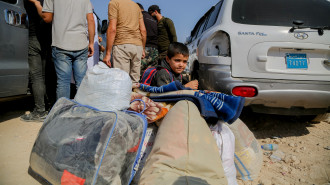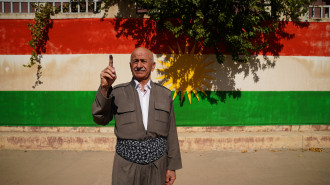Gaza power struggle melts hopes of ice-cream in summer sun
In the central Gaza Strip, there is an ice-cream factory standing empty.
The production line at the al-Awda factory has now completely shut down, as shortages in Gaza's power supply have reached their worst levels since 2006.
More than 100 workers have been stuck without work, with the gates of the factory shut for over a month. The giant machines only recently provided one of the major growth industries across this occupied coastal territory.
"Before the Israeli closure of Gaza [in 2007], we used to produce 2,000 litres of ice-cream per hour, with a total of 32,000 litres per two working shifts, a day," Manal Hassan told The New Arab.
"But for the moment, as we face the worst-ever power supply crisis, you can hear no machines buzzing and our workers have been sent home."
As the summer has been warming up here on the Mediterranean coast, not one ice-cream has been made in Gaza.
Hassan, the factory's executive director, noted that Alawda used to export two truckloads of ice-cream to the West Bank each. This was back in 2006, before the electricity crisis came to the surface.
"We are now facing difficulties marketing our other products, including wafer and biscuits, as the Israeli siege has been putting a great deal of restrictions on exports to the outside world or to nearby regions, including the Palestinian West Bank.
"Because of current economic conditions - including peoples' low purchasing power - we run the factory at only one third of our real capacity. Can you imagine? This month, wafer production lines worked only 10 days."
Power struggle
At another ice-cream factory in the central Gaza Strip, the al-Sham factory for soft drinks, Hatem Saleem told The New Arab that his production has been zero for almost seven weeks.
 |
With the crisis getting worse, we have stopped production and employed our 30 workers in producing some cake. Our customers, who include many local grocers, cannot afford our ice products |  |
"The reason is electricity. We used to distribute refrigerators to local stores, but this year, we could not. As you see, these machines can work for eight hours continually and can produce 2,000 liters a day. We used to run them using power generators, as the power supply was much better than it is now," said the factory director.
"But with the crisis getting worse, we have stopped production and employed our 30 workers in producing some cake. Our customers, who include many local grocers, cannot afford our ice products as they need costly power generators, with an income that cannot cover such extraordinary running costs."
Frozen meat also hit hard
Not only has ice-cream has been hit by the worsening electricity crisis, frozen meat shops have been feeling the heat. In one of the largest frozen meat stores in Gaza City's Aljalla suburb, the Lubbad store has been tackling the problem by running giant power generators throughout the holy month of Ramadan.
"Running power generators cost us about 10,000 shekels ($2,900) a month. We are being forced to run those generators as regular power supply has been less than four hours a day recently," said Ali Hannouna.
"This has been very costly to us, especially as people's ability to purchase has dropped to minimum levels. A customer now gets only a few kilos of either frozen meat, fish or other food items we sell here. Before the crisis got severe, some customers used to pick larger quantities of food.
"One kilo of lute fish is now sold for less than two US dollars. A few months ago, we sold it for about five US dollars."
The power supply provided by Gaza's electricity company, delivered eight hours a day before the latest crisis.
Customers complain
As customers choose from the frozen foods on offer at the Lubbad store, one speaks angrily about the current crisis.
 |
I am now here only to pick up some fish for today's fast-breaking. I can't get more fish because I only get power into my home for four hours a day |  |
"Some of the fresh vegetables, like tomatoes, have gone bad inside my home's refrigerator," said Mousa Yassin, a father of eight.
"I am now here only to pick up some fish for today's fast-breaking. I can't get more fish because I only get power into my home for four hours a day."
Unresolved crisis
The electricity crisis in Gaza has got worse, particularly in the past weeks, after a controversy between the ruling Hamas authorities in Gaza and the Palestinian Authority based in Ramallah returned to the surface.
The PA contends that the Gaza-based electricity company does not transfer details of electricity bills - including reliable tax information - collected from Gaza's residents and, therefore, no fuel to run Gaza's power plant is to be shipped to Gaza.
Authorities in Gaza argue that fuel needed to generate electricity should be exempt from the infamous "Blue" tax, and that one litre of fuel should be sold for only two shekels, not five.
The PA's position appears to have hardened, with allegations that Ramallah asked Israel to reduce the amount of power provided for Gaza and to stop monthly deductions of approximately 100 million NIS ($28m) from tax revenues collected on behalf of the PA, pertaining to the cost of power supplies to Gaza.
The Israel-provided power supply is reportedly set to be reduced by around 35 percent.
Gaza's consumption of power is estimated at 550 megawatt hours a day. Gaza's power plant provides around 40 percent of that amount, while Israeli lines supply 120 megawatt hours and Egypt provides a further 30 megawatt hours.
In 2006, Israeli bombed Gaza's power plant, reducing its generation capacity by almost fifty percent. In 2007, following internecine fighting which saw Hamas rout Fatah-led PA forces from Gaza, President Mahmoud Abbas ordered employees on the PA's payroll to boycott the Hamas-led government. Gaza's power plant has also been damaged in subsequent Israeli bombing campaigns.
Rami alMeghari is a Palestinian freelance journalist living and working in Gaza. Follow him on Twitter: @writeralmeghari

![Palestinians mourned the victims of an Israeli strike on Deir al-Balah [Getty]](/sites/default/files/styles/image_684x385/public/2024-11/GettyImages-2182362043.jpg?h=199d8c1f&itok=xSHZFbmc)


![The law could be enforced against teachers without prior notice [Getty]](/sites/default/files/styles/image_684x385/public/2178740715.jpeg?h=a5f2f23a&itok=hnqrCS4x)
 Follow the Middle East's top stories in English at The New Arab on Google News
Follow the Middle East's top stories in English at The New Arab on Google News


